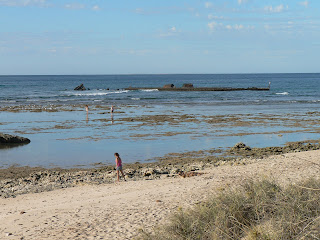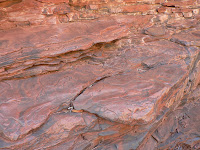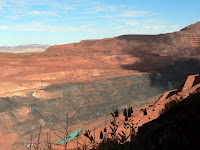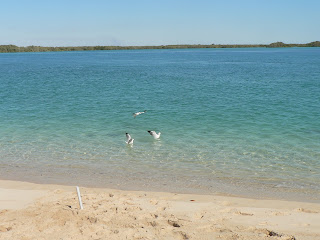(Magyar összefoglaló a végén)
Thursday, 19 July, Barradale Rest Area - We left Tom Price and travelled most of the day towards Exmouth. This road is called the Warlu Way, a scenic tourist drive going through Paraburdoo, another mining town with an airport used mostly by the miners on a fortnightly fly in - fly out shift schedule. The landscape is interesting, rugged red rock hills following the road on both sides. Very little traffic. We reached the main road following the West Coast at the Nanutarra Roadhouse. After filling up the tank we went on another 70 kms and stopped for the night at the Barradale Rest Area near the Yannarie river, a vast flat dusty place near the road. A popular place, many other campers around, but enough space for everyone. After a good shower again we had a nice quiet evening and night, apart from the rumbling of the occasional road trains passing by.
 |
| The SS Mildura |
 |
| Going snorkelling |
 |
| Swimming with a whale shark |
 |
| Face to face |
 |
| A manta ray |
We came back around 3.30 pm, had a long hot shower to warm up, then a relaxing evening.
 |
| Shothole Canyon |
 |
| Charles Knife Canyon |
Back in the van, we had lunch and a rest. In the afternoon we went shopping and hired two wetsuits for our planned snorkeling during the next two days on the West coast of the peninsula.
 |
| Our campsite at Pilgramunna |
 |
| A flock of cockatoos at the campsite |
 |
| Yardie Creek Gorge |
Then we drove back Northbound to see some of the other beaches and bays along the coast. We stopped at the Oyster Stacks, another good place for snorkelling at high tide.
 |
| Turquoise Bay |
After lunch we went snorkelling again. The water was a bit choppy and not as clear as yesterday, but we still saw a lot of different fish and corals. The rest of the afternoon we spent at the camp reading and resting. Later the sky became cloudy and by sunset it was almost fully overcast again. Just so that tomorrow morning we won't regret so much leaving this wonderful place...
Wednesday, 25 July, Carnarvon - Another frustrating windy night. The wind blew away the clouds, but woke us up many times. We packed up in the morning and went back to Exmouth, then continued our journey Southbound. We left with very good memories of this area, with the only regret that we did not see any emus, although the Exmouth tourist guide introduced them as "our reception committee".
 |
| Coral Bay |
Then off again, and a bit later we crossed the Tropic of Capricorn - unfortunately in the wrong direction... We have to say goodbye to the nice warm tropical days. The coutryside has also changed, the almost barren plains that we saw earlier gradually got more and more vegetation, and a bit later we were surrounded by banana and other fruit plantations, the first cultured land since the irrigated santalwood blocks beside Kunnunurra. Soon we arrived to Carnarvon, the agricultural centre of the region, and checked into a van park. We got the first taste of cold weather, overcast, windy and 18 degrees, which felt as a shock after the last few months. We'd better get used to it.
Our itinerary can be seen at the following Google Map:
http://g.co/maps/wcwv8
(Note that to see the route after Bowen, you need to move down to the bottom of the right panel, and select the following pages!)
Az elmúlt hetet Exmouth-ban és környékén, a Ningaloo Reef közelében töltöttük. Ez hasonló a Great Barrier Reef "Nagy korallzátony"-hoz a keleti partvidéken, de nem olyan hosszú, de legalább olyan érdekes és híres, ez is Világörökségi terület.
Múlt csütörtökön (jul. 19) jöttünk el Tom Price-ból, másfél napot utaztunk Exmouth-ig, kb 650 km. A csütörtök éjszakát egy útmenti pihenoben töltöttük, elég kellemes volt. Pénteken (jul 20) délelott értünk Exmouth-ba, ahol elore foglaltunk szállást 3 éjszakára egy kempingben. Exmouth egy észak felé kinyúló félsziget keleti oldalán van, és a csúcsán meg végig a külso, nyugati oldalán van a korallzátony, tengeri természetvédelmi terület, a nyugati parton pedig végig az ún. Cape Range nemzeti park. Elso fontos dolgunk az volt, hogy helyet foglaljunk egy "whale shark" túrán, ami itt a legnagyobb szenzáció, szerencsére sikerült. Aztán délután körülnéztünk a környéken. Megnéztük a közeli beach-eket, a yachtkikötot, a félsziget csúcsán egy világítótornyot, és egy 1907-ben zátonyra futott hajó roncsait. Az egész város nagyon újnak tunik, rengeteg új üdülo és egyéb épület és további építkezések, láthatólag jól megy a turista-biznisz.
Szombaton (jul 21) mentünk a whale shark hajótúrára. A whale shark (bálna-cápa) a világon a legnagyobb halfajta, 20 m-re hosszúra is megno, pedig csak planktonnal táplálkozik. Július táján mindig sok van ezen a vidéken, ez itt a fo turista-attrakció. A cápát repülorol keresik meg a vízben, és a helyzetét megadják a hajónak. Amikor a közelébe érünk, a hajót a cápa haladási irányában kicsit eléje kormányozzák, ekkor egy vezeto-búvár (spotter) beugrik a vízbe és ha sikerült meglátnia a cápát (ezek általában közvetlenül a felszín alatt úsznak lassan, nyitott szájjal, és így szurik ki a vízbol a planktont), feltartja a karját a víz fölött, akkor lehet a magunkfajtáknak is beugrani a szemüveggel, pipával és úszótalpakkal, és a cápa mellett úszni, követni amíg bírjuk. Általában nem sokáig lehet követni, vagy túl gyorsan úszik, vagy lebukik mélyebbre, de addig a rövid ideig is fantasztikus látvány egy ilyen tengeri óriást közelrol látni a természetes környezetében. Ezt többször is meg lehet ismételni. Nekünk kétszer sikerült, persze ezek nem voltak olyan óriásiak, csak kb 5-6 m hosszúak, de egész közelrol nagyon nagynak látszanak. Valóban egydülálló élmény volt, de elég sokat kellett szenvedni érte. A túra majdnem egész napos volt, egy elég kicsi nyitott hajóban, eros szél fújt és nem volt nagy meleg, sokat fáztunk útközben a vizes búvárruhában. Útközben azért volt még más attrakció is. Eloször a korallzátonyon belül mentünk egy kicsit snorkel-olni, sok érdekes halat meg korallt láttunk, bár itt a korall nem olyan színdús, mint a keleti parton, de azért jó volt. Késobb, útközben láttunk bálnát is amint kiugrott a vízbol, de elég messze volt. A vége felé meg hatalmas manta rájákkal is találkoztunk, azok mellé is be lehetett ugrani, de már nekünk elegünk volt az akcióból. Sajnos ezen az úton a legérdekesebb dolgok a vízalatt történtek, így saját felváteleink nincsenek róla, de a vezeto búvárnak volt víalatti kamerája, tole kaptuk a blogra feltett képeket.
Vasárnapra (jul 22) kicsit elromlott az ido, csepergett az eso, felhos volt, de azért kihasználtuk az idot. A félsziget keleti oldalán meglátogattunk két újabb kanyont, a Cape Range nemzeti parkban. Földúton kellett belemenni, az egyik (Shothole Canyon) a kanyon aljában haladt, a másik meg (Charles Knife) a felso peremén, mindkettonél sok szép vadregényes sziklás tájakat láttunk.
Hétfon átköltöztünk a félsziget nyugati oldalára, a Cape Range nemzeti park egyik táborhelyére. Ezeket a táborhelyeket elore le lehet foglalni egy weboldalon, de ilyenkor nagyon nagy a kereslet, nehéz helyet találni. Eloször nekünk sem sikerült, de másodszorra találtunk egy helyet a Pilgramunna nevu táborhelyen. A számozott táborhelyek közvetlenük a tengerparton vannak, csak kis csoportokban, max 8-10 hely, az egyedüli szolgáltatás egy pottyantós wc, de ide minden felszereléssel együtt szokás jönni. A táborhelyünk nagyon szép volt, közvetlenül a parton egy kis öböl mellett, és egész közel a parthoz már ott a korall, lehet snorkelolni. Még vasárnap béreltünk búvárruhát Exmouthban, mert azért a víz nem olyan meleg, kb 22-23 fokos lehet. Két napot töltöttünk itt, mindkét napon mentünk snorkelolni, sok szép halat és korallt láttunk. Hétfon nagyon szép ido volt, napsütés, meleg, csendes, nagyon élveztük. Éjszaka aztán feltámadt a szél, és egész kedden erosen és egyenetlenül fújt, a hullámzás is nagyobb lett, a víz nem volt olyan tiszta, de így is jó volt azért. Kedden elmentünk egy kicsit körülnézni is a park többi tengerparti szakaszán. A Turquoise Bay a leglátogatottabb hely, idehozzák a turista-buszokat napközben, egész valószínutlen világoskék színu a víz benne. A park déli végében még egy kanyont is megnéztünk, még nem untuk meg.
Ma, szerda (jul 25) reggel indultunk tovább onnan, újabb kb 300 km-el délebbre, sajnos egyre huvösebb tájak felé. Délben még megálltunk a Coral Bay-ben, egy másik kis turista-település a Ningalo Reef déli végében, szintén valószínutlenül kék tenger és fehér homok szegélyezi, aztán kicsit késobb átléptünk a Baktérítot, és nemrég megérkeztünk Carnarvon-ba. Ahogy közeledtünk, banán-ültetvények meg szoloskertek jelentek meg, hosszú ideje most eloször láttunk megmuvelt földet, ez egy fontos mezogazdasági központ. És meglepoen hideg, felhos szeles ido fogadott, a 18 fok elég sokkoló volt, de most már ehhez sajnos hozzá kell szoknunk, végül is itt most tél közepe van.
Az útvonalunk a következo Google Map-on látható:
http://g.co/maps/wcwv8
(A Bowen utáni szakaszokhoz le kell menni a jobboldali panel aljára, és a következo oldalakra kattintani!!)
















































